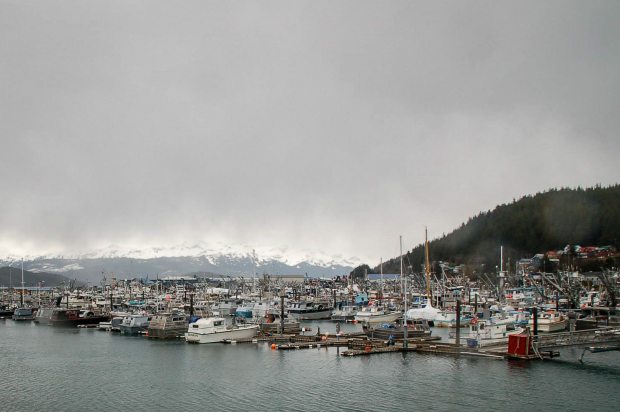By Laine Welch | For the Capital City Weekly
June 25, 2014
Uncertainty best sums up the mood as fishermen and processors await the world’s biggest sockeye salmon run at Bristol Bay. In fact, it’s being called the riskiest season in recent memory in the 2014 Sockeye Market Analysis, a biannual report done by the McDowell Group for the fishermen-run Bristol Bay Regional Seafood Development Association.
As presaged by buyer pushback at seafood trade shows earlier this year in Boston and Brussels, for the first time since 2010 the starting price for the first sockeyes from Copper River took a $0.50/lb dip. At an average $3.50/lb, it was down 13 percent for fishermen from 2013.
“Probably more so than any recent year, processors are having pressure from both the buying side with more competition for fish in Bristol Bay, and on the selling side there is a very large sockeye forecast from the Fraser River (in British Columbia). And that fishery takes place in August well after Alaska’s sockeye fisheries are done,” said Andy Wink, seafood project manager at McDowell Group.
“If buyers hold off and there is a big Fraser run, it could leave Alaska processors holding some high-priced sockeye inventory. We’ll have to wait and see what happens with wholesale prices, but in general, there are more downside risks this year,” he added.
The expected catch at Fraser River is about 10 million sockeye, but it could be double that if fishermen and processors have the capacity to handle it.
Of course, farmed salmon remains a big market competitor – and in play this summer is red salmon from Russia. That fish is making big inroads into markets where it hasn’t been before.
“It wasn’t till 2013 when we really saw Russian sockeye going in any significant volume to markets outside of Japan,” Wink explained. “As our sockeyes become more expensive, Japan has been buying more from Russia. But last year we saw Russian sockeye exports outside of Japan go up 580 percent!”
On the upside, Wink said Alaska sockeye is an ever more popular brand, especially in the U.S.
“There is still a lot of demand, especially for fresh and frozen products, and there is strong demand from salmon smokers in Europe, and a growing market in the U.S. market. That’s really supported the entire Bristol Bay fishery over the last several years,” he said.
Sockeye salmon are Alaska’s must valuable species by far, usually worth two-thirds of the total statewide harvest. The 2014 Alaska sockeye harvest is projected at 33.6 million fish; roughly 18 million of the reds should come from Bristol Bay.
Find the easy-to-read 2014 Salmon Market Analysis at www.bbrsda.com.
Worker relief
Alaska seafood processors will soon get relief from worker shortages with the reinstatement of the J-1 Visa Summer Work/Travel Program. The J-1 program allows companies to recruit workers from outside the US when they can’t find enough Alaskans or workers from the Lower 48 during the busy salmon season. The State Department dropped seafood industry workers from the J-1 program two years ago.
Sens. Murkowski and Begich were successful in getting seafood workers added back into the J-1 Visa program. On Friday, the measure passed as part of the State and Foreign Operations Appropriations Bill, and it now heads to the full Senate.
Salmon skin cream
A chance discovery by farmed salmon hatchery workers has spawned a line of skin care products that keep skin softer and younger looking.
“Aquapreneurs” in Norway became curious several years ago after they noticed that hatchery workers who spent long hours handling salmon fry in cold seawater had softer, smoother hands. Researchers at Norway’s University of Science and Technology discovered the skin-softening component came from the enzyme zonase, found in the hatching fluid of the salmon eggs. The enzyme’s task is to digest the protein structure of the tough egg shells without harming the tiny fish. The scientists hailed this dual ability as the secret behind the beneficial properties for human skin.
Now, Norway-based Aqua Bio Technology, which develops marine based ingredients for the personal care industry, has launched the zonase-infused product as Aquabeautine XL. Another personal care product using salmon hatching fluid is set to be launched at the end of the year, according to ABT’s website.
Death by sunscreen
All that sunblock being slathered on beachgoers around the world is causing major damage to ocean coral. A study funded by the European Commission revealed the mix of 20 compounds used to protect skin from the harmful effects of the sun causes rapid bleaching of coral reefs.
The World Trade Organization reports that 10 percent of world tourism takes place in tropical areas, with nearly 80 million people visiting coral reefs each year. The WTO estimates that up to 6,000 tons of sunscreen is released into reef areas each year – and that 10 percent of the world’s coral reefs are at risk of ‘death by sunscreen.’
While Alaska’s deep-sea corals face threats from ocean acidification, they are safe from sunscreen. Unlike tropical varieties, Alaska corals don’t form reefs – they grow into dense gardens and can live for hundreds of years. The waters surrounding the Aleutian Islands are believed to harbor the most abundant and diverse cold-water corals in the world.
Laine Welch has been covering news of Alaska’s fishing industry since 1988. She lives in Kodiak. Visit her website at www.fishradio.com


